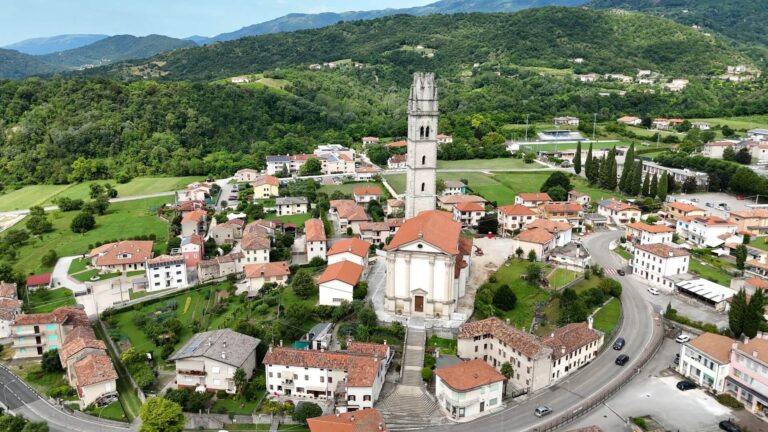ARTISTS’ ROADS
LE VIE DEGLI ARTISTI
watch the videos at the bottom of the page!
FREGONA
Fregona and Its Bell Tower
Fregona is its bell tower.
The bell tower stands beside the church.
It embodies humanity’s longing to touch the heavens.
It is the ladder dreamed by Jacob, son of Isaac, upon which angels ascended and descended.
Yet Fregona’s bell tower is also the measure of this land, a tangle of hills and streams that seem to resist the steep descent of Mount Pizzoc.
Its stones tell the story of this place. Not only the piera dolza of Caglieron, that gentle sandstone, expertly quarried since the sixteenth century, carved into door jambs and window frames, bringing a piece of Fregona to every village in the foothills.
But also the blue stone, for centuries extracted from now-silent quarries above Ciser, one of Fregona’s hamlets, was used.
Yet the bell tower tells another tale, one of extraordinary physical, financial, and organisational effort.
For this grand undertaking became a unifying dream. Over thirty years, families, both civic and ecclesial, who had once clashed, came together, driven by the shared desire to raise the most beautiful bell tower.
More than 60 metres high, its foundations plunge 20 metres deep. It was meant to soar even higher, a spire, never built, would have added 12 more metres.
The work began in 1869. The Veneto had only just joined the Kingdom of Italy. Rome was not yet the capital.
And immediately, the project stalled, too ambitious, too demanding.
They say, “More stone was needed from the foundations to the square, than from the square to the top.”
In 1880, work resumed. A year later, the Bishop of Ceneda, Corrado Maria Cavriani, blessed the first stone, burying beneath it a parchment and coins, to mark this great beginning for posterity.
By 1885, the foundations were complete.
In 1891, the first great arched windows were opened.
In 1902, the bell tower was finished.
The very year that the bell tower of St Mark’s in Venice collapsed.
But this bell tower has a soul. A man who dreamed its sharp-edged form, its perfect spiral staircase coiled inside an incredible and solid perfect circle.
His name was Francesco Ciprian, born in Osigo in 1840.
He knew the hard and soft stones of this land. And how to honour them.
He found success in what was then not another country, but part of the Austrian Empire. It is said he even crafted works for Emperor Franz Joseph himself.
In the 1880s, he returned, and built the bell tower of Osigo.
But his true vision remained fixed on Fregona.
The old bell tower had been demolished. The bells, hoisted on a makeshift wooden trestle, the campanila, rang from an unworthy perch.
He imagined something different, a tower unlike any in the region.
He did not look to St Mark’s, nor to the old watchtowers later repurposed for this purpose.
He drew inspiration from the towers of the Votive Church, and the Vienna City Hall, raised between 1872 and 1883. The style was Neo-Gothic.
Chamfered corners. Rusticated stonework. Horizontal cornices. Double-arched windows. Spires. Floral carvings. Grotesques in the shape of dragons, guarding against demons. Just like the great Gothic cathedrals of the thirteenth century. Yet in Fregona, everything is rendered with even greater solidity.
The bell tower gave its people the sound of bells once more.
What was life without bells?
They marked the hours, announced the feast days, and even rang out in mourning.
Then as now, they enter the lives of those who choose to listen and tell the story of a community.
MORE EXPERIENCES!
Come punte di compasso! I campanili.
- Vazzola
- Colle Umberto
- Susegana
- Follina
MULTIMEDIAL MAP: “ARTISTS’ ROADS – LE VIE DEGLI ARTISTI- EN”!

